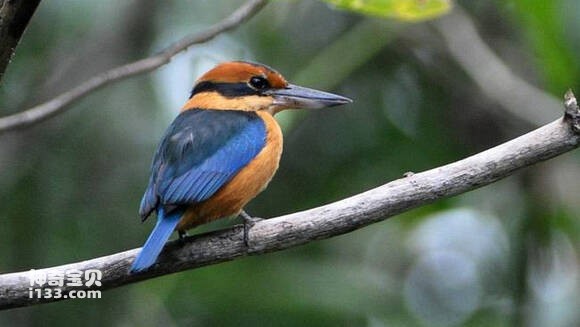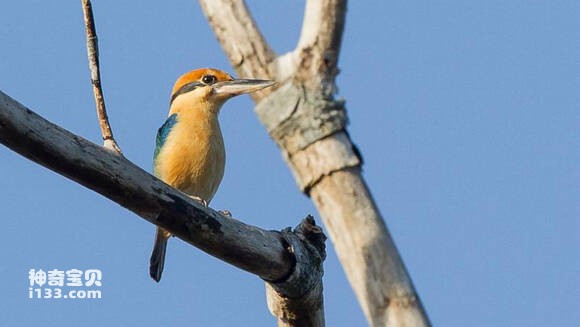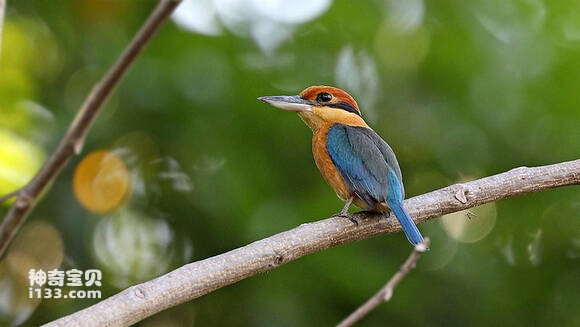Todirhamphus australasia
IUCN
LCBasic Information
Scientific classification
- name:Todirhamphus australasia
- Scientific Name:Todirhamphus australasia,Halcyon australasia,australasia,Timor Kingfisher
- Outline:Climbing birds
- Family:
Vital signs
- length:About 21 cm
- Weight:28-58g
- lifetime:No textual research information is available
Feature
Distribution and Habitat
It is found in Indonesia and East Timor.
The Crown emerald lives in forest environments, from sea level to 700 meters above sea level. Live on the edge of a forest, in a monsoon forest, in a wooded area, in a plantation, on a plantation, in a shaded area near a village or farm. They seem to particularly like the dense foliage of trees as a habitat.
Appearance
The crown jade is 21 cm long, the male bird weighs 28-58 grams, and the female bird weighs 39-55 grams. Androgynous. Adult birds have orange-red caps on their heads that cover their eyebrows. The eyes begin with light yellow or orange. The face of the species is covered with a black mask that reaches to the neck. White chin. The throat, sides of the neck and other parts are light orange. Cinnamon-orange upper neck; Back and shoulder blades oil green; Chest white, lower body brown yellow; Waist blue-green; Bright blue at the end; The wings are green; The tail is blue-green; There is a small black green patch under the corner of both wings, and below it are red wings. The maxilla is brown black, and the mandible is pale yellow with a black feather margin. The iris is brown with small feathers forming a ring around it. The legs are black. Young birds resemble adult females. But the chest feathers are all black. The mouth is pale.
The mouth is thick and long like a chisel, the base is w
Details
Todirhamphus australasia, Halcyon australasia, australasia, Timor Kingfisher, has 5 subspecies (
1. The subspecies Todirhamphus australasia is found in the Lesser Sunda Islands (Lombok, Sumbaweta and Timor-Leste). 2. Todirhamphus australasia dammerianus is found in the eastern part of the Lesser Sunda Islands (Damar and Babar). 3. The inland subspecies Todirhamphus australasia interpositus is found in the eastern Lesser Sunda Islands (Leti and Moa). 4. Todirhamphus australasia odites is found in the Taningbar Islands. 5. The subspecies Todirhamphus australasia tringorum is found on Romen Island in the eastern part of the Lesser Sunda Islands.

The crown jade is often alone, generally resting on the stumps and rocks of the river, and sometimes on the low branches of small trees near the river. Often for a long time motionless staring at the water, as soon as the fish and shrimp in the water, immediately with a very rapid and fierce posture into the water with the mouth to catch. Sometimes the wings are suspended in the air, looking down at the water, and the food immediately plunges into the water and is quickly captured. The prey is usually brought back to the habitat, beaten on a tree branch or stone, and eaten whole after the fish is dead. Sometimes they also fly in a straight line at a low altitude over the water, flying very fast, often screaming while flying.

The Crown jade mainly eats invertebrates, such as crickets, spiders, scorpions, and snails. It also eats small vertebrates such as small fish, small snakes and lizards.
The Crown jade emits a rapid trill: "' ch'w 'hee-ch 'w'hee" for 5 to 12 seconds. They are also often noisy.

The crown emerald produces one nest a year, nests on the earth cliff or on the embankment of the river, uses the mouth to dig the tunnel type cave for the nest, and lays eggs in May and June every year. Some also drill holes in tree trunks for nests. Oval oval, pure white, smooth without spots, about 29.4×26.2 mm in size. The male and female birds incubate the eggs in turn, and the incubation period is 19-21 days. The chicks are late sex and can leave the nest to fly for 23-30 days after hatching.

The range of the crown emerald is wide but sporadic and generally uncommon, and due to changes in the forests in which it resides, human exploitation and habitat loss, monitoring within its range has identified a decline in the population of this species. Through ecological research, the survival of the species has been in a near critical state.
Listed on the International Union for Conservation of Nature (IUCN) 2013 Red List of Threatened Species ver 3.1 - Near Threatened (NT).
Protect wild animals and eliminate wild meat.
Maintaining ecological balance is everyone's responsibility!








